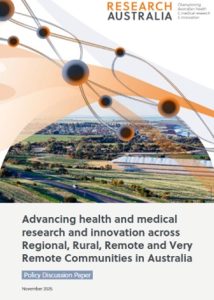 Nearly 30% of Australians live in regional, rural, remote or very remote (RRRvR) communities, yet the funding for rural health and medical research is not comparable. RRRvR research, researchers, and research institutions excel in connectivity and co-design, establishing research priorities led by local needs and impactful service delivery models. Infrastructure such as regional universities, rural health departments and research institutes are essential to local communities – contributing to both healthier communities and a healthier local economies.
Nearly 30% of Australians live in regional, rural, remote or very remote (RRRvR) communities, yet the funding for rural health and medical research is not comparable. RRRvR research, researchers, and research institutions excel in connectivity and co-design, establishing research priorities led by local needs and impactful service delivery models. Infrastructure such as regional universities, rural health departments and research institutes are essential to local communities – contributing to both healthier communities and a healthier local economies.
Despite the strengths communities face unique health challenges, including funding inequities, workforce gaps and research infrastructure gaps. Our paper, developed with input from Research Australia’s membership identifies key priority areas for enhancing the importance of dedicated RRRvR research. By undertaking these systemic reforms and incorporating the recommendations into the National Health and Medical Research Strategy, we can elevate the strengths of regional, rural, remote and very remote communities, not only for equity but for the health of the nation.
Read the full report and our key recommendations here.
